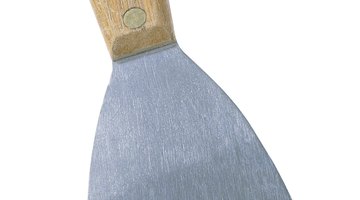Recommended Wood Filler for Termite Damaged Wood
Any type of wood filler is suitable for fixing wood damaged by termites. Several brands of wood filler, including common brands such as Minwax, Elmer's and LePage, are available at most stores that sell this manner of product.

When fixing termite-damaged wood, the preparation is just as important as the application of the wood filler.
Wood Filler
Wood filler, which is also known as "plastic wood," is produced by several companies. It is available in solvent-based and non-solvent varieties. Both are suitable for the same list of uses, but the non-solvent variety is safer to work with indoors because it doesn't give off harmful vapors. No specific brand of wood filler bills itself as ideal for fixing termite damage, but all wood fillers are suitable for filling a variety of holes and gouges in wood.
Preparation
Before you begin to apply the wood filler, prepare the damaged wood in two different ways. First, use a utility knife or chisel to chip out the damaged wood. Because of the termites, this wood is soft and weak and will not provide a solid surface to which the wood filler can bond. Additionally, use a screwdriver to put one or more screws into the damaged area. Screws not only fill the gap with something durable, but they also provide a solid bonding surface.
Application
Wood filler is available in tubs and squeeze bottles. If using a tub, scoop some of the filler on to a putty knife and push the filler into the damaged wood. Take the time to fill as much of the void as possible by turning the putty knife at a variety of angles to force the filler inside. With a squeeze bottle, put the nozzle into the void in the wood and squeeze the bottle until the void is full. Wipe the putty on the surface of the void smooth.
Finishing
Most wood filler dries completely within 30 minutes, but always check the product specifications on your tub or bottle. When the filler is completely dry, sand off the excess with 180-grit sandpaper. Finish the job by staining or painting the patched area to match the surrounding wood.
The Drip Cap
- Any type of wood filler is suitable for fixing wood damaged by termites.
- No specific brand of wood filler bills itself as ideal for fixing termite damage, but all wood fillers are suitable for filling a variety of holes and gouges in wood.
- Because of the termites, this wood is soft and weak and will not provide a solid surface to which the wood filler can bond.
- Wood filler is available in tubs and squeeze bottles.
- If using a tub, scoop some of the filler on to a putty knife and push the filler into the damaged wood.
References
Writer Bio
Toronto-based journalist William McCoy has been writing since 1997, specializing in topics such as sports, nutrition and health. He serves as the Studio's sports and recreation section expert. McCoy is a journalism graduate of Ryerson University.
Photo Credits
- Comstock/Comstock/Getty Images
- Comstock/Comstock/Getty Images
More Articles



